Photo: © Serge D’IGNAZIO
Within the framework of the long-term project “Kunst am Wegesrand” (“Art by the Wayside”), which Anette C. Halm has already realized or is in the process of planning in Germany in site-specific formats (in Nürtingen and Ostfildern in 2021, Baden-Baden in 2022 and in Böblingen in 2023), she will organize performances through Paris from August 9, 2023 – October 16, 2023, and a “Marche Rive Gauche” through Paris on October 8th, in collaboration with numerous artists who will present performances and actions in and around historical architectural monuments. The locations of the event include the Palais Royal connected via the Académie française, the Jardin du Luxembourg, and the Panthéon. The march not only aims to draw attention to the history of women’s rights and the struggle to free women from dependence on a male-dominated society, but also to commemorate women’s rights advocates who were active in Paris in particular. In an accompanying painting project, Anette C. Halm has followed their traces in the city’s historic cemeteries. Together, these two bodies of work provide an authentic account of Halm’s stay in Paris, reflecting both on the lived life and the future. Here, the city of love also emerges as a city of women’s emancipation – with all its light and dark sides.
The Performances
Wednesday
09.08.2023
09:00 am
Père-Lachaise
Les Grandes Femmes
This video work is the prelude to the “Marche Rive Gauche,” for it is here that many “Grandes Femmes” rest. Thus, this work is intended to be a place of remembrance and at the same time a tribute to all the “strong women” who have prevailed in the struggle to abolish old conventions. The battle cry of the French Revolution, which to this day evokes liberty, equality, and fraternity, will undergo a small but consistent and logical rededication in the “Marche” – in fulfillment of equality. In the third part, inherent as a motto in the entire action, it is transformed in dance-like sentiment to: Freedom, equality, and … humanity.
Text: Günter Baumann, Camera: Anette C. Halm, Photo: © Anette C. Halm
Anette C. Halm
Dancer & Coreographer: Hsing-Ya Wu
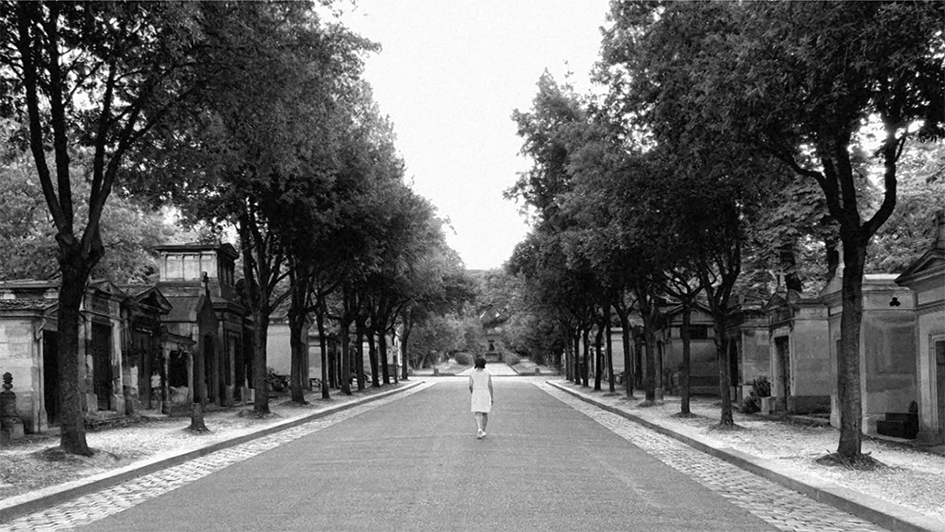
The performances
Sunday
08.10.2023
11:00 am
Palais Royal
Womankind
On marche … pour les femmes. Together with the artists of her project as well as with guests and other participants, Anette C. Halm stages her performance “Womankind” in honor of the resolute women’s rights activist Olympe de Gouges, i.e. Marie Gouze (1748-1793). The revolutionary wrote the “Declaration of the Rights of Woman and Citizen” in 1791 and two years later became a victim of Robbespierre’s regime of terror – she died under the guillotine. With clenched fists as a sign of struggle for feminism, the artist lies on the ground: tense, resolute: knowing that Olympe de Gouges read out the ‘Rights for Women’ here in 1791. From here Anette will start the march, with the words:
Pour les femmes!
Pour les droits des femmes!
Liberté! Egalité! Humanité!
Text: Günter Baumann, Camera: Jürgen Bubeck, Photo: © Serge D’IGNAZIO
Anette C. Halm
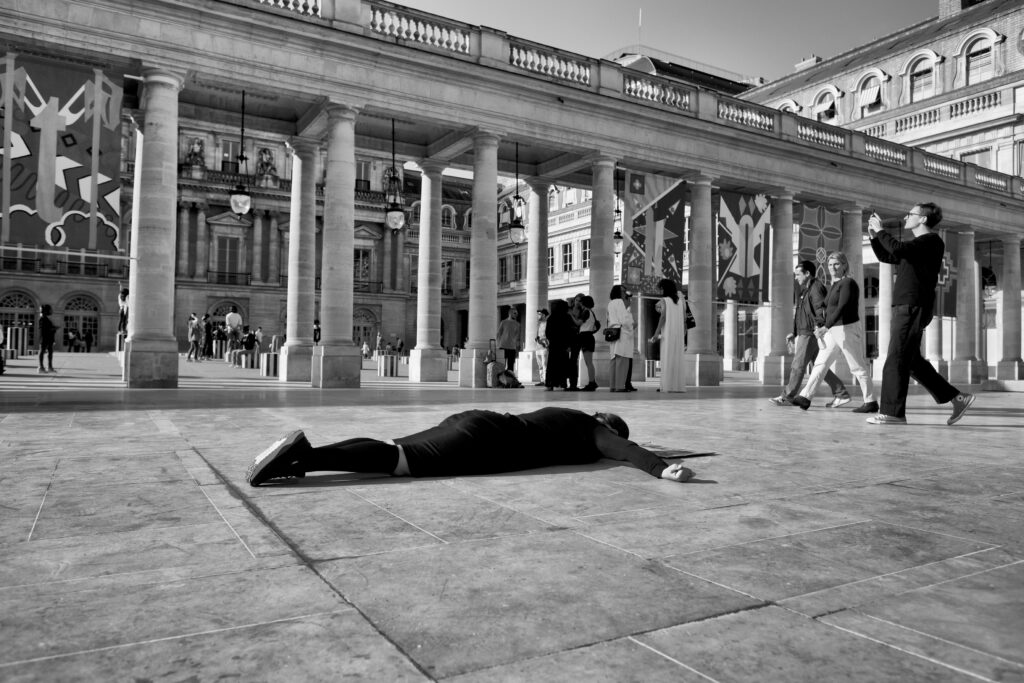
Sunday
08.10.2023
11:00 am – End
Streaming from Seoul Café Flore
during the walk
In-fragilité
The fairy tale of the fairy tale with the glass slipper. The image of the glass wedding slipper might be considered dreamy if it weren’t so terribly uncomfortable and unpleasant to wear. Yena Kim’s glass slipper performance references the fairy tales of Grimm’s “Aschenputtel” and Walt Disney’s “Cinderella,” which can be traced back to Charles Perrault, who published the fairy tale “Cendrillon ou la Petite Pantoufle de verre” in 1697. Using glass slippers, the performance exposes the transparent, invisible shoes as a sign of hidden dependency and discrimination.
Text: Günter Baumann, Camera: Seunghwan Yoon
Assistant: Jiwon Yun, Photo: © Seunghwan Yoon
Yena Kim
With the kind support of Hyung Jin Park
Glass studio: FLUX
instagram@glassart_flux
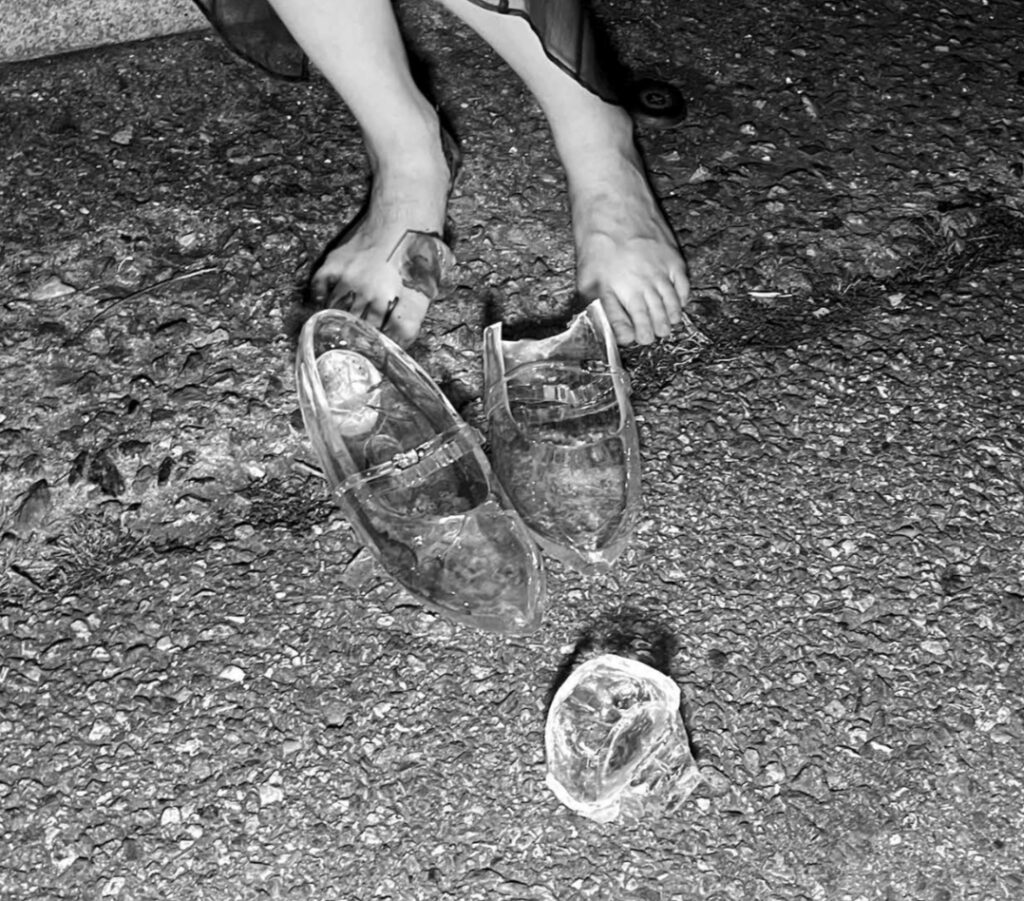
Sunday
08.10.2023
11:30 am – End
Carrousel du Louvre during the walk
Über die Naht (Over the seam)
Approaching each other via the seam. Lana Koeters’s performance takes place in the background – or, to be more precise, in the middle of the action. While the other performers are in action, the artist selects random pairs and temporarily sews them together. She only works when the spectators or marchers are resting in order to watch the other contributions. With needle and thread, she sets about sewing the shirts, jackets, or pants of the supporting protagonists. In this way, she creates temporary living sculptures that are characterized by a sewn sameness and at the same time remain themselves.
Text: Günter Baumann, Camera: Jürgen Bubeck, Photo: © Serge D’IGNAZIO
Lana Koeters
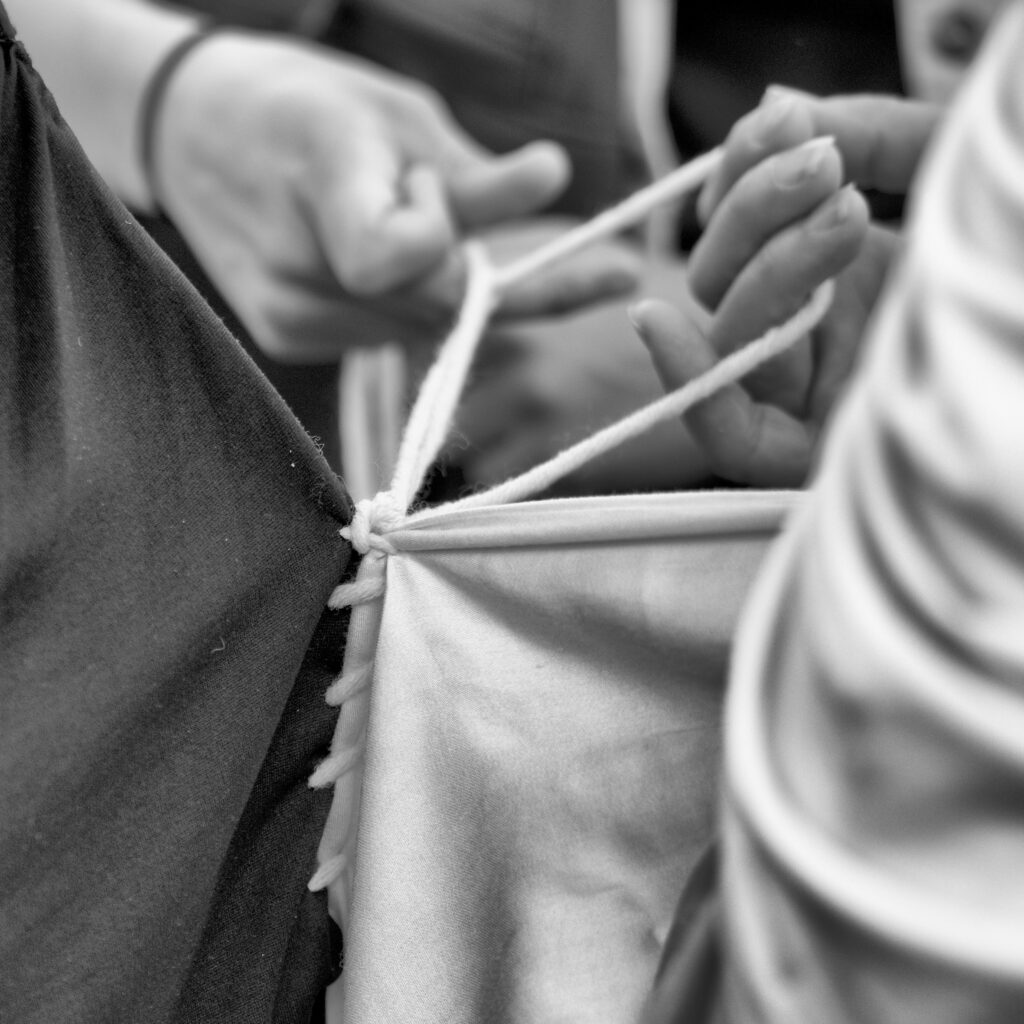
Sunday
08.10.2023
12:00 pm
Académie française
Faites Votre Jeu (Make Your Play)
Live your life, make your play. Britta M. Ischka slips into the role of the early women’s rights activist Marie de Gournay (1565–1645), who remained unapologetically single throughout her life. The writer and philosopher believed that the human spirit was neither female nor male – she therefore championed self-determination and the development of personal potential. Her spiritual successor can be seen with a fan of fabric unfurling over upward-curving arms, in the pose of Leonardo da Vinci’s Vitruvian Man. Where better to strike such a pose than in front of the Académie française?
Text: Günter Baumann, Camera: Jürgen Bubeck, Photo: © Serge D’IGNAZIO
Britta M. Ischka
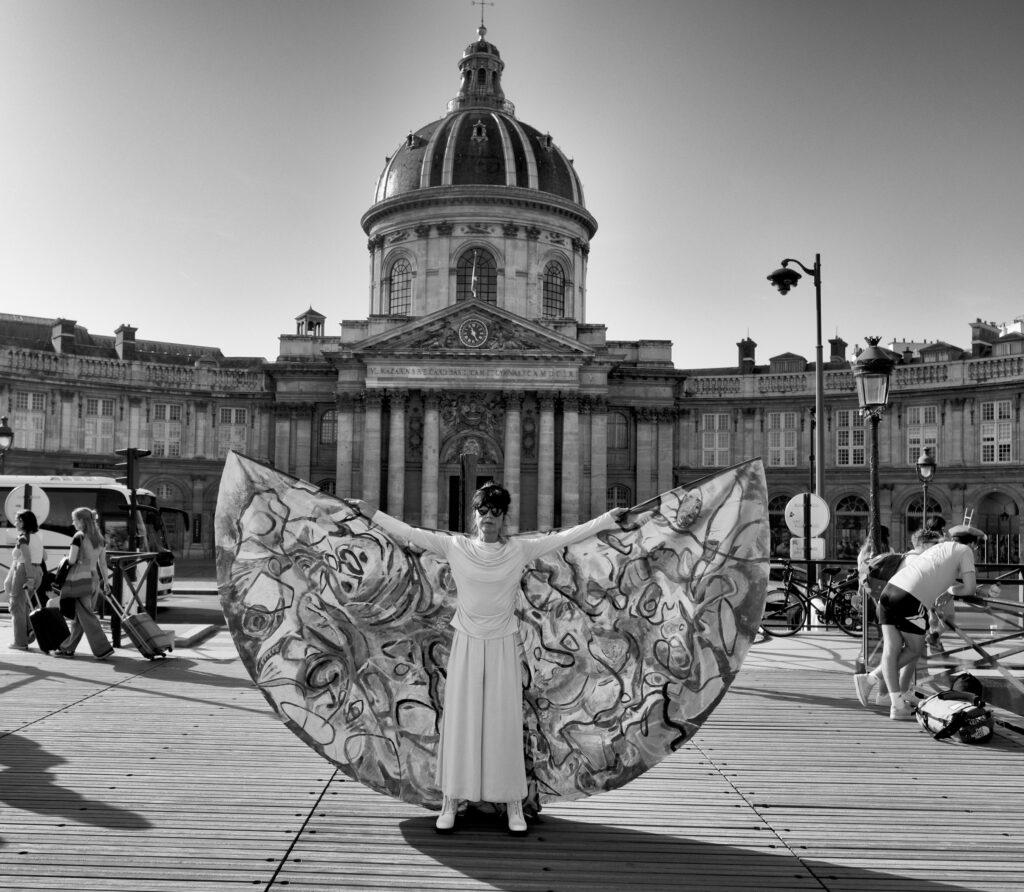
Sunday
08.10.2023
12:30 pm
Le Procope
The Fe-Male Gaze
On the offensiveness of ice cream. Sissi-Madelaine Schöllhuber links the cultural history
of eating ice cream to how we approach licking ice cream in public. It is believed that the Italian Francesco Procopio dei Coltelli opened the first ice cream parlor, Le Procope in Paris, in the 17th century and was the first to create this sweet seduction. Hanging in the restaurant today is the last letter Marie-Antoinette wrote on the day of her execution. Whether she ever ate ice cream is another matter – whether it was considered obscene for a woman to lick ice cream from a cone at the time remains an open question. Sissi pokes fun at the fact that it is still considered so in uptight circles today.
Text: Günter Baumann, Camera: Jürgen Bubeck, Photo: © Serge D’IGNAZIO
Sissi-Madelaine Schöllhuber
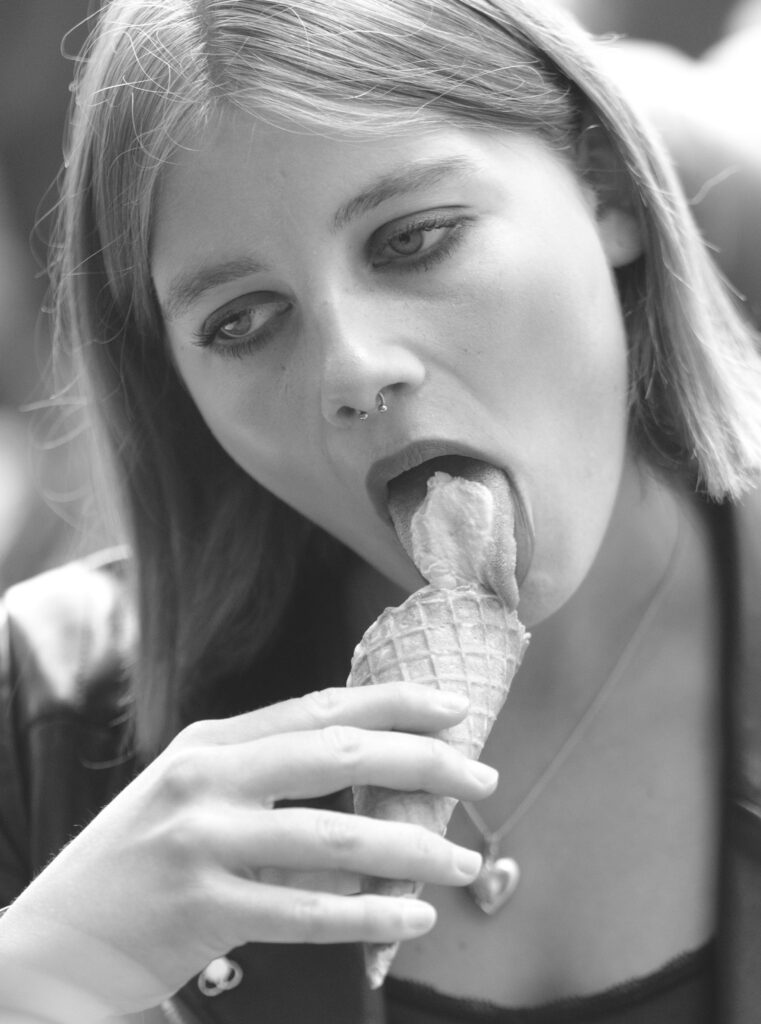
Sunday
08.10.2023
01:00 pm
Jardin du Luxembourg Fontaine Médici
Dem Unerreichbaren nahe (Close to the unreachable)
It’s easier to dance without a corset. Beate Herdtle’s performance is a tribute to Isadora Duncan (1877 – 1927). The legendary expressive dancer revolutionized dance through free natural movements, in contrast to the occidental stage tradition with pointe dancing and corsets. The expressive movements of the artist at the Fontaine de Médici show the liberation from the corset like a “fountain of light” (Duncan, 1927), freely flowing into space in the form of waves, like a jet of water spreading out from the Fontaine de Médici. Women were already getting rid of corsets during World War I in order to be more defensible. This performance is a statement of their political message.
Text: Günter Baumann, Camera: Jürgen Bubeck, Photo: © Serge D’IGNAZIO
Beate Herdtle
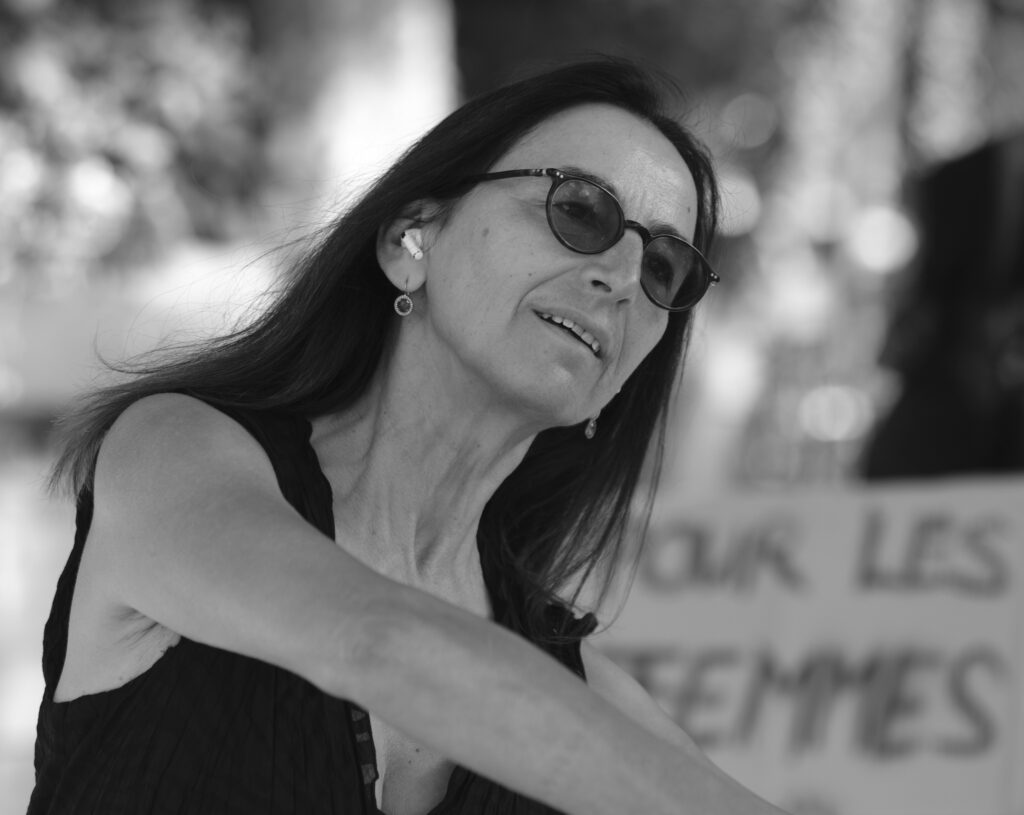
Sunday
08.10.2023
02:00 pm
Panthéon
Hair Cut
Hair for women’s equality. Wearing a simple dress, Ezgi Böttger walks up to the consecrated site of the Panthéon and offers her cut-off braid of hair as a kind of sacrifice. In doing so, she reminds us that since Sophie Berthelot was buried in the Panthéon in 1907, just six women – compared to seventy-five men – have found their way into the hallowed halls. The most recent was Josephine Baker, who was laid to rest here in 2021 – not in the flesh but with a cenotaph. These days, though, it’s impossible not to think of the brave women in Iran who cut off their hair to demonstrate against the compulsory headscarf.
Text: Günter Baumann, Camera: Jürgen Bubeck, Photo: © Serge D’IGNAZIO
Ezgi Böttger
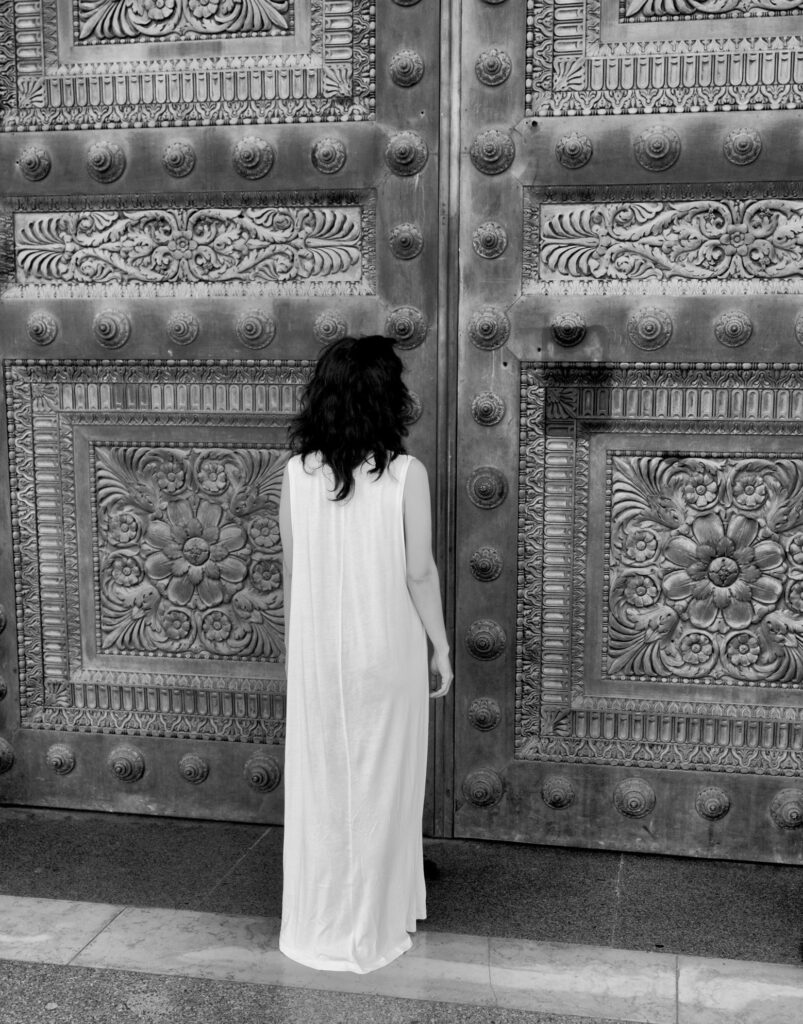
Sunday
08.10.2023
02:30 pm
during the walk
Église Saint-Étienne-du-Mont
Du musst mehr tun, als nur ein paar Blümchen malen (You need to do more than just paint some flowers)
The black veil harbors secrets. In art, especially in film, it is used again and again with great effect, and at the march it will draw viewers’ attention. Angela Vanini will slip in and out of these moments, veiled for the entire duration of the action – as a visibly invisible person. She also alludes to forms of oppression that are hidden, draping herself with chains: burden, restricted freedom of movement, symbol of the imposed narrowness of female possibilities for growth.
Text: Günter Baumann, Camera: Jürgen Bubeck, Photo: © Serge D’IGNAZIO
Angela Vanini
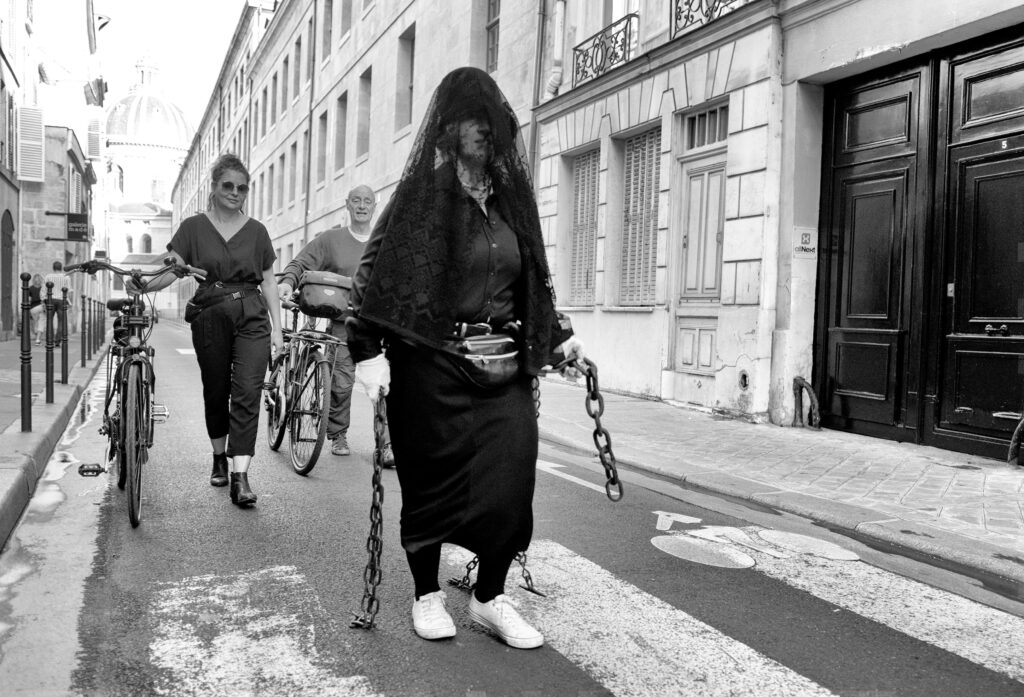
Sunday
08.10.2023
03:00 pm
Place de la Sorbonne
Säbeln, Knebeln, Hebeln (Sabers, gags, levers)
Hair It’s the cabbage that does it. Marie Zbikowska’s work is about reconciling motherhood and life as an artist, or the difficulty of combining the two. From the perspective of the dual fields of “art and work,” “art and motherhood,” “work and motherhood,” and “work and success,” she recites relevant French texts while eating cabbage – dressed in a lab coat. The rich symbolism of cabbage, sometimes negative, sometimes positive, lends an enigmatic quality to the action. The performance aims to address the everyday reality of the double burden and of work itself, calling for improvements that are long overdue in the 21st century.
Text: Günter Baumann, Camera: Jürgen Bubeck, Photo: © Serge D’IGNAZIO
Marie Zbikowska
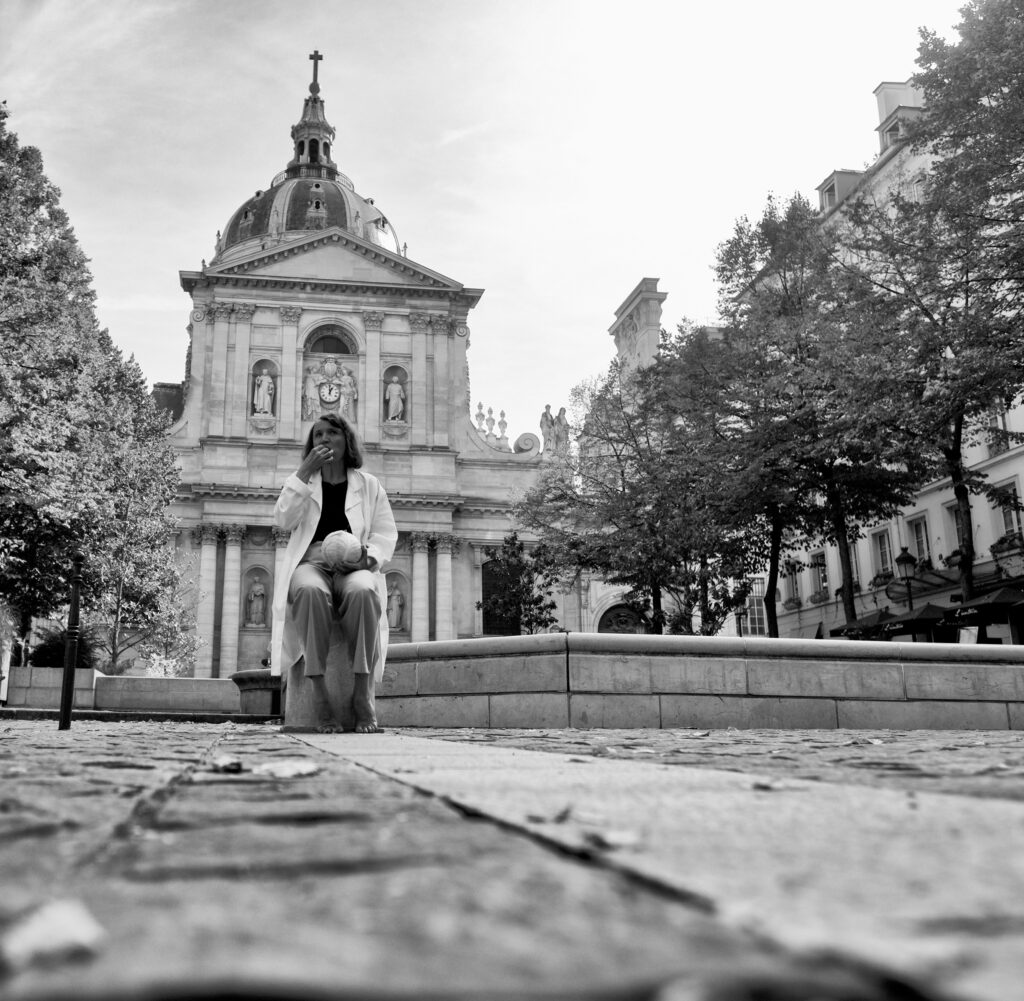
Sunday
08.10.2023
03:30 pm
Tribunal Correctionnel de Paris
Beinfreiheit (Legliberty)
Attraction isn’t a matter of revealing clothing. In her performance, Andrea Isa reminds us of the French law forbidding women to wear trousers in Paris – a law that has only recently been abolished. Although French women did not obey it, the existence of this unspoken coercion to wear skirts and dresses, limiting the freedom of choice, invites parody. By wearing several pairs of pants on top of each other, hanging from suspenders like shapeless layers, the artist denies the feminine charms imagined by men. Marlene Dietrich (1901–1992) sends her regards. Ninety years ago she said: “First I showed my legs, and the public was outraged; now I hide my legs, and they are outraged too.”
Text: Günter Baumann, Camera: Jürgen Bubeck, Photo: © Serge D’IGNAZIO
Andrea Isa

Sunday
08.10.2023
04:30 pm
Cité internationale des arts
Danae_2023
Danae’s role reversal. We know that Zeus appeared to his many lovers in all sorts of disguises and magical manifestations. He met Danae, who was imprisoned by her father, in the form of a golden rain. Fabian Widukind Penzkofer breaks open the myth – which was meant to show the omnipotence of the father of the gods – by transforming himself into Danae (or perhaps her twin brother?) and posing under a profane shower of water. Here, the (male or perhaps female?) voyeurism that accompanies myths, and that art history in particular has been so fond of putting on canvas, is doubly challenged.
Text: Günter Baumann, Camera: Jürgen Bubeck, Photo: © Serge D’IGNAZIO
Fabian Widukind Penzkofer

With the kind support of the Ministeriums für Wissenschaft, Forschung und Kunst Baden-Württemberg, Cité Internationale des Arts Paris, SV SparkassenVersicherung, Stiftung der Landesbank Baden-Württemberg, Marli Hoppe-Ritter Stiftung, Kreissparkasse Böblingen and Kunstverein Böblingen e. V.

